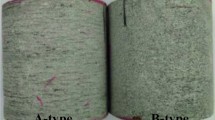Abstract
A suite of Sierra Madera Impact deformed rocks was studied and magnetic analyses were performed. We characterized the magnetic signatures of two locations, sites A and B that have different physical characteristics of shock fractured structures as well as the magnetic signatures. Shatter cone at site A has a fine-scale (few to ∼10 mm) distributed array of complete shatter cones with sharp apex. Natural remanent magnetization (NRM) of site A shatter cone is distributed within the plane that is perpendicular to the apexes of the cones. Shatter cone at site B shows no apparent cone shape or apex, instead, a relatively larger scale and multiple striated joint set (MSJS) and sinusoidal continuous peak. NRM of site B shatter cone is clustered along the apexes. The difference in magnetization direction is a likely indicator of the shock pressure where parallel to apex indicates pressures larger than 10 GPa and perpendicular to apex indicate pressures less than 10 GPa. Intensities of NRM and saturation isothermal remanent magnetization (SIRM) contrast and fluctuate within a shatter cone as well as in between two sites. We observed a random orientation of magnetic vector directions and amplitudes changing over small scales leading to the absence of coherent macro-scale signature.
Similar content being viewed by others
References
Ashworth J.R. and Schneider H., 1985. Deformation and transformation in experimentally shock-loaded quartz. Phys. Chem. Miner., 11, 241–249.
Baratoux D. and Melosh H.J., 2003. The formation of shatter cones by shock wave interference during impacting. Earth Planet. Sci. Lett., 216, 43–54.
Boon J.D. and Albritton C.C. Jr., 1936. Meteorite craters and their possible relationship to “cryptovolcanic structures”. Field and Laboratory, 5, 1–9.
Carporzen L., Gilder S.A. and Hart R.J., 2005. Palaeomagnetism of the Vredefort meteorite crater and implications for craters on Mars. Nature, 435, 198–201.
Carporzen L., Gilder S.A. and Hart R.J., 2006. Origin and implication of two Verwey transitions in the basement rocks of the Vredefort meteorite crater, South Africa. Earth Planet. Sci. Lett., 251, 305–317.
Eggleton R.E. and Shoemaker E.M., 1961. Breccia at Sierra Madera, Texas. U.S. Geological Survey Professional Paper, 424-D, D151–D153.
French B.M., 1998. Traces of Catastrophe, a Handbook of Shock-Metamorphic Effects in Terrestrial Meteorite Impact Structures. Lunar and Planetary Institute, Contribution No. 954.
Gibson H.M. and Spray J.G., 1998. Shock-induced melting and vaporization of shatter cone surfaces: evidence from the Sudbury impact structure. Meteorit. Planet. Sci., 33, 329–336.
Grieve R.A.F., Langenhorst F. and Stoffler D., 1996. Shock metamorphism of quartz in nature and experiment. 2. Significance in geosciences. Meteorit. Planet. Sci., 31, 6–35.
Hargraves R.B. and Perkins W.E., 1969. Investigations of the effect of shock on natrual remanent magnetism. J. Geophys. Res., 74, 2576–2589.
Hart R.J., Hargraves R.B., Andreoli M.A.G., Tredoux M. and Doucoure C.M., 1995. Magnetic anomaly near the center of the Vredfort structure-implications for impact-related magnetic signatures. Geology, 23, 277–280.
Hart R.J., Connell S.H., Cloete M. and Mare L., 2000. ’super magnetic’ rocks generated by shock metamorphism from the centre of the Vredefort impact structure, South Africa. S. Afr. J. Geol., 103, 151–155.
Huson S.A., Foit F.F., Watkinson A.J. and Pope M.C., 2006. X-ray diffraction powder patterns and thin section observations from the Sierra Madera Impact Structure. Lunar and Planetary Science, XXXVII, 2377.pdf (http://www.lpi.usra.edu/meetings/lpsc2006/pdf/2377.pdf).
Kletetschka G., Kohout T. and Wasilewski P.J., 2003a. Magnetic remanence in the Murchison meteorite. Meteorit. Planet. Sci., 38, 399–405.
Kletetschka G., Ness N.F., Wasilewski P.J., Connerney J.E.P. and Acuna M.H., 2003b. Possible mineral sources of magentic anomalies on Mars. The Leading Edge, 22, 766–768.
Kletetschka G., Acuna M.H., Kohout T., Wasilewski P.J. and Connerney J.E.P., 2004a. An empirical scaling law for acquisition of thermoremanent magnetization (vol 225, pg 279, 2004). Earth Planet. Sci. Lett., 228, 573–573.
Kletetschka G., Connerney J.E.P., Ness N.F. and Acuna M.H., 2004b. Pressure effects on martian crustal magnetization near large impact basins. Meteorit. Planet. Sci., 39, 1839–1848.
Nicolaysen L.O. and Reimold W.U., 1999. Vredefort shatter cones revisited. J. Geophys. Res.-Solid Earth, 104, 4911–4930.
Pohl J., 1981. Planetary and lunar magnetism: In: ESA The Solar System and Its Exploration, 115–120 (SEE N82-26087 16-88).
Sagy A., Fineberg J. and Reches Z., 2004. Shatter cones: branched, rapid fractures formed by shock impact. J. Geophys. Res.-Solid Earth, 109, B10209.
Sagy A., Reches Z. and Fineberg J., 2002. Dynamic fracture by large extraterrestrial impacts as the origin of shatter cones. Nature, 418, 310–313.
Stoffler D. and Langenhorst F., 1994. Shock metamorphism of quartz in nature and experiment. 1. Basic observation and theory. Meteoritics, 29, 155–181.
Wasilewski P., 1977. Magnetic and microstructural properties of some lodestones. Phys. Earth Planet. Inter., 15, 349–362.
Wasilewski P. and Kletetschka G., 1999. Lodestone-nature’s only permanent magnet, what it is and how it gets charged. Geophys. Res. Lett., 26, 2275–2278.
Wieland F., Reimold W.U. and Gibson R.L., 2006. New observations on shatter cones in the Vredefort impact structure, South Africa, and evaluation of current hypotheses for shatter cone formation. Meteorit. Planet. Sci., 41, 1737–1759.
Wilshire H.G., Howard K.A. and Offield T.W., 1971. Impact breccias in carbonate rocks, Sierra Madera, Texas. Geol. Soc. Am. Bull., 82, 1009–1017.
Wilshire H.G., Offield T.W., Howard K.A. and Cummings D., 1972. Geology of the Sierra Madera cryptoexplosion structure, Pecos County, Texas. USGS Professional Paper, No. 599-H, 1–49.
Author information
Authors and Affiliations
Corresponding author
Rights and permissions
About this article
Cite this article
Adachi, T., Kletetschka, G. Impact-pressure controlled orientation of shatter cone magnetizations in Sierra Madera, Texas, USA. Stud Geophys Geod 52, 237–254 (2008). https://doi.org/10.1007/s11200-008-0016-0
Received:
Revised:
Accepted:
Published:
Issue Date:
DOI: https://doi.org/10.1007/s11200-008-0016-0




